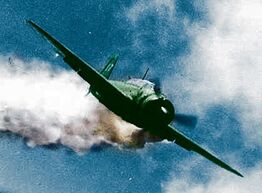
A Kamikaze moments before attempting to hit the USS Essex.
| “ | Right off the bat a Jap plane made a suicide dive at the cruiser St. Louis there was a big explosion and flames were seen shortly from the stern. Another one tried to do the same thing but he was shot down. - Seaman First Class James J. Fahey about the Battle of Leyte Gulf | ” |
The Kamikaze (translation - "Divine Wind") was a type of last-ditch suicide attack that was used by Japan during World War II. It made use of pilots purposely ramming their aircraft, sometimes packed full of explosives, into US ships.[1] Success varied, but well over 40 US ships alone were sunk due to kamikaze attacks. In addition, many ships were also put out of action for the rest of the war, such as the USS Enterprise (CV-6).
The term Divine Wind was a reference to the typhoon which sank a Mongol battle fleet, which was being prepared for an invasion of Japan in August of 1281.[2] Some of the most common aircraft used in the attacks were the Mitsubishi A6M Rei-sen and Yokosuka D4Y Susei.
History[]
The first recorded Kamikaze attack was in 1941 during the Bombing of Pearl Harbor. At this time however, suicide attacks were only used as a last resort. Of course, the attacks were stepped up in 1944 when Japan was getting more and more desperate to repel the ever closer US forces. Now, Japanese airmen were being trained and formed into special units for Kamikaze operations. Early successes in 1944 caused many new Japanese men to enlist for kamikaze operations.[3]These pilots were sometimes easily shot down, because of their poor training.

Japanese Kamikaze attack on the USS Essex
Japanese men were also influenced to enlist in the special attack units because of the traditional Japanese code, which puts honour ahead of one's self.[4] The attacks became more and more frequent as the war dragged on into 1945 and especially at the Battle of Okinawa were the attacks most prevalent.
References[]
- ↑ http://www.eyewitnesstohistory.com/kamikaze.htm
- ↑ Room, Adrian. Brewer's Dictionary of Phrase and Fable - Millennium Edition. Cassell & co. (2002), Page 648.
- ↑ Rice Jr., Earle. World War II:Kamikazes. Lucent Books (2000), Page 59
- ↑ http://www.u-s-history.com/pages/h1740.html
